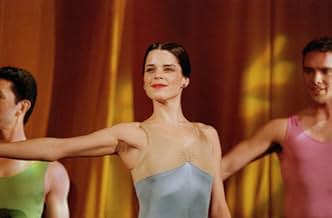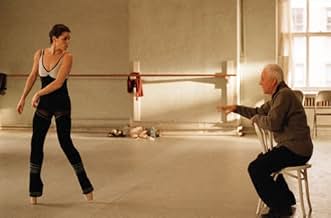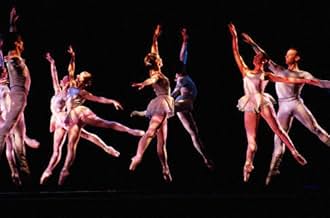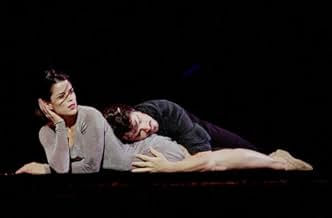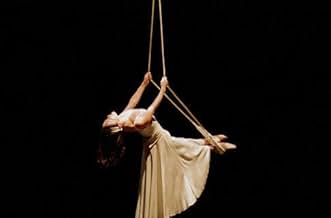VALUTAZIONE IMDb
6,2/10
7014
LA TUA VALUTAZIONE
Uno sguardo sul mondo del balletto: le storie umane dei ballerini alle prese con le esigenze di una professione straordinaria quanto impegnativa.Uno sguardo sul mondo del balletto: le storie umane dei ballerini alle prese con le esigenze di una professione straordinaria quanto impegnativa.Uno sguardo sul mondo del balletto: le storie umane dei ballerini alle prese con le esigenze di una professione straordinaria quanto impegnativa.
- Regia
- Sceneggiatura
- Star
- Premi
- 2 candidature totali
Barbara E. Robertson
- Harriet
- (as Barbara Robertson)
Davis C. Robertson
- Alec - Joffrey Dancer
- (as Davis Robertson)
Recensioni in evidenza
I suppose you can call this splendid movie a documentary showing several months in the life of the Joffrey Ballet of Chicago. However, as there are some dramatized elements (albeit to a minimum), you can't technically call it a documentary. And yet, it's more truthful than many "full" documentaries. Completely free from contamination of melodrama, the movie shows us, in a matter-of-fact manner, things behind the stage dedication and sacrifices, lucky breaks that even the top talents sometimes need, experienced performers arguing anainst new ideas, injury and understudy stepping in at a moment's notice, disappointment from being fired, and much more.
Doing what he does best, master Altman gives you an inconspicuous spot in the rehearsal hall, in the meeting room, back stage, to show you how an idea evolves right from an artist's concept to a successful performance the road that is sometimes painful, sometimes exhilarating and everything in between, the process that affects the lives of the people who are part of the whole. Overlapping dialogue here is not just Altman's artistic and technical trademark, but the way people REALLY speak. Through his amazing deployment of the camera, he also gives the audience a kaleidoscope of events and emotions that are fleeting and fluid, and yet remain with you long after the movie.
In addition to the insight of the documentary, dance lovers will enjoy the generous helping of dance scenes, particularly the outdoor performance in a thunder storm at the beginning. And although personal story is not the point of this movie, the depiction of the relationship between the characters played by Neve Campbell (the dancer) and James Franco (the chef) is wonderful. The scene of their first meeting is a joy to watch she is playing pool by herself and really enjoying it while he, a drink in hand, regards her somewhat stoically at a distance. The two of them are depicted in so many angles, sometimes in the same frame, sometimes separately. This scene is so mesmerizing that you'll forget the passage of time. At long last, they make eye contact and smile. Then, a cut to the next morning in her apartment when they are just waking up, as he offers to cook breakfast for them. An absolutely beautiful sequence.
Campbell and Franco are simply wonderful. The icon of the movie, however, is artistic director of the company Alberto Antonelli , generally known as "Mr A", who comes off larger than life with the flare of Malcolm McDowell, who undoubted is remembered best from "A clockwork orange".
To people who have experienced the joy of stage performance, even in a very modest way of an amateur choir or theatre group, there is the bonus of additional empathy the sometimes not so smooth rehearsals, the panic as the performance approaches and nothing seems to work, the last minute jitters before curtain, the final jubilation when everything miraculously falls into place and the sincere applause of the audience. Such empathy!
Doing what he does best, master Altman gives you an inconspicuous spot in the rehearsal hall, in the meeting room, back stage, to show you how an idea evolves right from an artist's concept to a successful performance the road that is sometimes painful, sometimes exhilarating and everything in between, the process that affects the lives of the people who are part of the whole. Overlapping dialogue here is not just Altman's artistic and technical trademark, but the way people REALLY speak. Through his amazing deployment of the camera, he also gives the audience a kaleidoscope of events and emotions that are fleeting and fluid, and yet remain with you long after the movie.
In addition to the insight of the documentary, dance lovers will enjoy the generous helping of dance scenes, particularly the outdoor performance in a thunder storm at the beginning. And although personal story is not the point of this movie, the depiction of the relationship between the characters played by Neve Campbell (the dancer) and James Franco (the chef) is wonderful. The scene of their first meeting is a joy to watch she is playing pool by herself and really enjoying it while he, a drink in hand, regards her somewhat stoically at a distance. The two of them are depicted in so many angles, sometimes in the same frame, sometimes separately. This scene is so mesmerizing that you'll forget the passage of time. At long last, they make eye contact and smile. Then, a cut to the next morning in her apartment when they are just waking up, as he offers to cook breakfast for them. An absolutely beautiful sequence.
Campbell and Franco are simply wonderful. The icon of the movie, however, is artistic director of the company Alberto Antonelli , generally known as "Mr A", who comes off larger than life with the flare of Malcolm McDowell, who undoubted is remembered best from "A clockwork orange".
To people who have experienced the joy of stage performance, even in a very modest way of an amateur choir or theatre group, there is the bonus of additional empathy the sometimes not so smooth rehearsals, the panic as the performance approaches and nothing seems to work, the last minute jitters before curtain, the final jubilation when everything miraculously falls into place and the sincere applause of the audience. Such empathy!
Some of the dances are tiny religious experiences. The film doesn't look nearly as good as some of Altman's others, but there are flashes of awesome beauty: a topless male dancer alone in a room with golden beams of light, and Neve Campbell in her bath. The movie looks at the queeny pretensions of the boys (and their fathers), the dancers' sex lives (who are more '60s than their instructor knows), and the company leader, played by Malcolm McDowell, whose occasional flakiness is caught by one black dancer. I couldn't help but think of McDowell as an Altman self-criticism: an elderly director working with small budgets, prone to artiness, who champions art as being organic, who rounds up a large crew of performers and calls them "babies." The day-in-the-life shapelessness of the movie didn't at all bother me, though one character, who asks to stay in a dancer's apartment, is dropped pretty quickly. And James Franco is in it. 9/10
Lets hope that Altman makes films for another 20 years and that he stays as adventuresome as he currently is.
In 'The Long Goodbye' Altman invented a rather new camera stance, literally asking the actors to improvise staging and having the camera discovering them.
It took a few decades for him to get back to such experiments with 'Gosford.' Now he takes it even further with perhaps the purest problem in film cinematography: how do you film dance?
Forget that this features Campbell in a vanity role: she is good enough and doesn't detract. Forget about any modicum of plot: there isn't any. And unlike 'Nashville' or the similarly selfreferential 'Player' there is no cynical commentary.
The commentary itself is selfreferential this time. Yes, this time the center of the film is how 'Mr A' orchestrates movement and images. This is most of all about himself, and is far, far more intelligent and subtle than say, 'Blowup.'
But along the way, you get possibly the best dance experience on film. That's because they've been able to use many cameras. There are not as many as 'Dancer in the Dark,' but each camera dances, engages with the dance and the dance of people and objects around the dance. So we get four layers of dance: the actual ballet, the orchestration of people around the production, the dancing cameras (enhanced by non-radical appearing radical editing) and the dance within the mind of Mr A who encourages, follows and captures them all.
Ted's Evaluation -- 3 of 3: Worth watching.
In 'The Long Goodbye' Altman invented a rather new camera stance, literally asking the actors to improvise staging and having the camera discovering them.
It took a few decades for him to get back to such experiments with 'Gosford.' Now he takes it even further with perhaps the purest problem in film cinematography: how do you film dance?
Forget that this features Campbell in a vanity role: she is good enough and doesn't detract. Forget about any modicum of plot: there isn't any. And unlike 'Nashville' or the similarly selfreferential 'Player' there is no cynical commentary.
The commentary itself is selfreferential this time. Yes, this time the center of the film is how 'Mr A' orchestrates movement and images. This is most of all about himself, and is far, far more intelligent and subtle than say, 'Blowup.'
But along the way, you get possibly the best dance experience on film. That's because they've been able to use many cameras. There are not as many as 'Dancer in the Dark,' but each camera dances, engages with the dance and the dance of people and objects around the dance. So we get four layers of dance: the actual ballet, the orchestration of people around the production, the dancing cameras (enhanced by non-radical appearing radical editing) and the dance within the mind of Mr A who encourages, follows and captures them all.
Ted's Evaluation -- 3 of 3: Worth watching.
Ugh. The problem with The Company is that it's not a Robert Altman film. His touch is evident in the filmmaking and fly-on-the-Wall feel of the movie, but it's not his movie. It's Neve Campbell's, who wrote, produced, and starred in it. Campbell spent years with the national ballet and this movie was a labor of that passion. However, that is precisely where it goes wrong. It shoots for the wrong audience. Dancers will likely love this movie but they are the choir. They know how a dance company works, the back dealing and politics. They don't need this movie. The rest of us don't learn anything, or at least learn just enough to know that professional dancing is a horrible way to live. The dancing was beautiful, including Neve's, although she doesn't look quite as polished as her back ups in the company, but the characters were shallow and you are never given anything to grab onto to care about any of them. The only ones you root for the ones who are injured or fired so they can get out of that horrible horrible place. Such a disappointment on so many levels. The only thing that does come off well is the Joffrey. You actually leave the theater wondering if the Ballet company underwrote the production as a marketing expense.
The DVD extras with some movies make the film seem better than it did just watching it. "The Company" is a good example.
I'd wondered, briefly, why star Neve Campbell also got producer credit. The DVD 'making of' documentary explains that the whole project was her idea; she'd been a dancer long before she took up acting, and wanted to combine the two. She chose Altman to direct, because of his skill at portraying relations and interactions among people in groups.
Altman did a fine job depicting dance, both rehearsals and performances. Campbell showed she can still dance. Malcolm McDowell gave a great performance as the acerbic company director. The Joffrey dancers were brilliant. Altman has created a dazzling cinematic album of what the world of dance is like at the beginning of the 21st century.
But the story arc was weak. This was no accident. In a recent (October 2004) interview, Altman said:
Question: "Why do you think you're drawn to stories about big groups of people sharing the same space? Did it have anything to do with growing up in such a large, close-knit family?"
Robert Altman: "Possibly. I don't know. That's a little too cerebral for me. I'm not much interested in stories anyway. I'm more interested in reactive behavior."
That sums up "The Company" very nicely. The movie is a montage of scenes of "reactive behavior" among realistic characters, and in this it is more like real life than a more structured story would have been.
Of course there is some story structure here, involving the creation of a new dance. This story is engaging, because the outside choreographer is a fey flake, and dance disaster seems foredoomed. But the dancers, being good soldiers, follow his orders diligently. And despite all expectations, at least all of my expectations, their climactic performance is superb.
But this story is not central to the movie. Again like life, it unfolds amidst all sorts of other organizational and interpersonal drama.
And for this reason the movie left me unsatisfied. Part of what I look for in movies, and in books, is a story arc: a beginning, a middle, and an end. I look for this precisely because life is rarely that neat. Many directors deliver this arc (and many more try to, and fail). Robert Altman chose not to try. He is free to do that, and I am free to rate this movie 7/10.
I'd wondered, briefly, why star Neve Campbell also got producer credit. The DVD 'making of' documentary explains that the whole project was her idea; she'd been a dancer long before she took up acting, and wanted to combine the two. She chose Altman to direct, because of his skill at portraying relations and interactions among people in groups.
Altman did a fine job depicting dance, both rehearsals and performances. Campbell showed she can still dance. Malcolm McDowell gave a great performance as the acerbic company director. The Joffrey dancers were brilliant. Altman has created a dazzling cinematic album of what the world of dance is like at the beginning of the 21st century.
But the story arc was weak. This was no accident. In a recent (October 2004) interview, Altman said:
Question: "Why do you think you're drawn to stories about big groups of people sharing the same space? Did it have anything to do with growing up in such a large, close-knit family?"
Robert Altman: "Possibly. I don't know. That's a little too cerebral for me. I'm not much interested in stories anyway. I'm more interested in reactive behavior."
That sums up "The Company" very nicely. The movie is a montage of scenes of "reactive behavior" among realistic characters, and in this it is more like real life than a more structured story would have been.
Of course there is some story structure here, involving the creation of a new dance. This story is engaging, because the outside choreographer is a fey flake, and dance disaster seems foredoomed. But the dancers, being good soldiers, follow his orders diligently. And despite all expectations, at least all of my expectations, their climactic performance is superb.
But this story is not central to the movie. Again like life, it unfolds amidst all sorts of other organizational and interpersonal drama.
And for this reason the movie left me unsatisfied. Part of what I look for in movies, and in books, is a story arc: a beginning, a middle, and an end. I look for this precisely because life is rarely that neat. Many directors deliver this arc (and many more try to, and fail). Robert Altman chose not to try. He is free to do that, and I am free to rate this movie 7/10.
Lo sapevi?
- QuizNeve Campbell lost thousands of dollars of her own money to ensure that her fellow cast members received their wages.
- BlooperAt about 1:10 while counting during a rehearsal, Harriet skips the 6th count of 8.
- Citazioni
Alberto Antonelli: Ry, honey, let's scramble some ideas, instead of some asshole who contradicts me.
- Curiosità sui creditiAfter the closing credits begin rolling, the dancers continue to take their final bows, and the audience continues to applaud.
I più visti
Accedi per valutare e creare un elenco di titoli salvati per ottenere consigli personalizzati
- How long is The Company?Powered by Alexa
Dettagli
Botteghino
- Budget
- 15.000.000 USD (previsto)
- Lordo Stati Uniti e Canada
- 2.283.914 USD
- Fine settimana di apertura Stati Uniti e Canada
- 93.776 USD
- 28 dic 2003
- Lordo in tutto il mondo
- 6.415.017 USD
- Tempo di esecuzione
- 1h 52min(112 min)
- Colore
- Mix di suoni
- Proporzioni
- 2.35 : 1
Contribuisci a questa pagina
Suggerisci una modifica o aggiungi i contenuti mancanti








